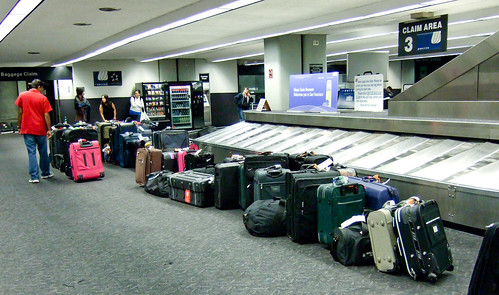As we travel we learn that some of our preconceived ideas about our carry-on and checked-in luggage aren’t true. Unfortunately, some of those notions are dashed by unfortunate experiences. Hopefully, you haven’t had to learn the hard way.
Possibly you can avoid a future luggage problem by reading from my list of top ten luggage myths which I’ve busted from my own experiences and those which readers have shared with me.
1. If you have lost or damaged luggage, your airline will fully reimburse you for the loss. — That’s a myth which too many travelers believe is true and pay for it. For example, like most US domestic airlines, US Airways limits their liability on domestic flights to $3,300, and for international flights, approximately $1,807 per passenger. A luggage rule of thumb I use is if you don’t need it, leave it at home.
2. Airlines will reimburse you for anything lost or damaged packed in your luggage, up to their limit of liability. — That’s a myth which cost a friend of mine dearly a few years ago, when returning from Aruba. He packed his laptop computer in his checked-in luggage. When he opened his bag at home, he found the screen had cracked. When he called the airline they explained to him, they don’t reimburse for loss or damage to valuables packed in luggage.
In fact, airlines generally won’t assume any liability for valuable or fragile items, such as cash, photographic gear, electronic equipment, jewelry, or even prescription medication. All valuables and breakables which you need on a trip should be packed in your carry-on luggage.
3. If you have to gate-check a carry-on bag for a flight on a regional jet, the airlines’ rules on their liability limitations don’t apply to the gate-checked bag. — That’s just a myth. If you’re flying on a regional jet or small propeller plane, make sure none of your valuables or breakables are in your gate-checked bag.
4. Checked-in and carry-on luggage rules are the same on all airlines and in all ticket classes. — It’s a myth of course. Most US domestic airlines have similar luggage rules, but there are differences. US Airways and American Airlines both limit carry-ons to a total of 45in (114cm), but US Airways has a weight limit of 50lbs (22.7kg). Internationally, the size and weight limit luggage rules vary widely according to the airline, the type of plane, and the ticket class.
5. If you’re taking connecting flights on different airlines to your destination, your luggage will be automatically accepted by each connecting airline. — A friend of mine found out this was a myth the hard way. He had to pay a substantial penalty when changing planes in Europe. His luggage was too big and heavy under the connecting airline’s regulations.
6. While occasional thefts of or from checked-in luggage are well documented, there is no risk of theft from your carry-ons. — This myth was shattered forever in 2010 when it was reported that the son of Hollywood celebrity, Cybill Shepherd, was arrested for stealing items out of other passengers’ carry-ons during a flight to Philadelphia. I keep my carry-ons locked while inflight, and directly over my head or slightly in front of me, if possible, to keep an eye on them.
7. You can carry a photographic equipment bag on board your US domestic flight, in addition to your carry-on and personal item. — This is a myth that TSA accidentally created. TSA says on their website, “You may carry one (1) bag of photographic equipment in addition to one (1) carry-on and one (1) personal item through the screening checkpoint.” (TSA has a disclaimer on the page.) The only problem is while it might be permitted by TSA, US domestic airlines don’t allow a third carry-on item. They will generally permit you to carry a camera around your neck or over your shoulder in addition to your normal carry-ons.
8. Only checked-in luggage is generally examined at US Customs, upon arriving in the US. — I have no idea how this myth was started, but I assure you it isn’t true. If you’re trying to hide purchases from Customs, don’t put it in your carry-ons, just declare it and pay the duty. (Added after publishing: Sometimes you may be able to sign a customs waiver to have airline personnel act in your behalf at US Customs.)
9. If your luggage is lost, your airline will deliver it to you if they find it. — This is another myth, as while airlines may deliver your luggage to you (US Airways has delivered delayed luggage to my home.) they may not, especially if it’s coming in from out of the country. If Customs wishes to examine your luggage, you’ll be required to go to the airport, as Customs requires your presence before they examine your luggage.
10. If you travel on multiple airlines on a trip your luggage can always be checked through to you ultimate destination. — This myth is easy to understand, because more often than not you can check your bags through different airlines to your final destination. The problem is not all airlines have ticketing or interlining agreements. For example, if you’re flying Southwest to Philadelphia, then US Airways to your final destination, you’ll have to pick up your luggage at Southwest baggage claim then take it to US Airways and check it in. The two airlines don’t have an interlining agreement.
After many years working in corporate America as a chemical engineer, executive and eventually CFO of a multinational manufacturer, Ned founded a tech consulting company and later restarted NSL Photography, his photography business. Before entering the corporate world, Ned worked as a Public Health Engineer for the Philadelphia Department of Public Health. As a well known corporate, travel and wildlife photographer, Ned travels the world writing about travel and photography, as well as running photography workshops, seminars and photowalks. Visit Ned’s Photography Blog and Galleries.


